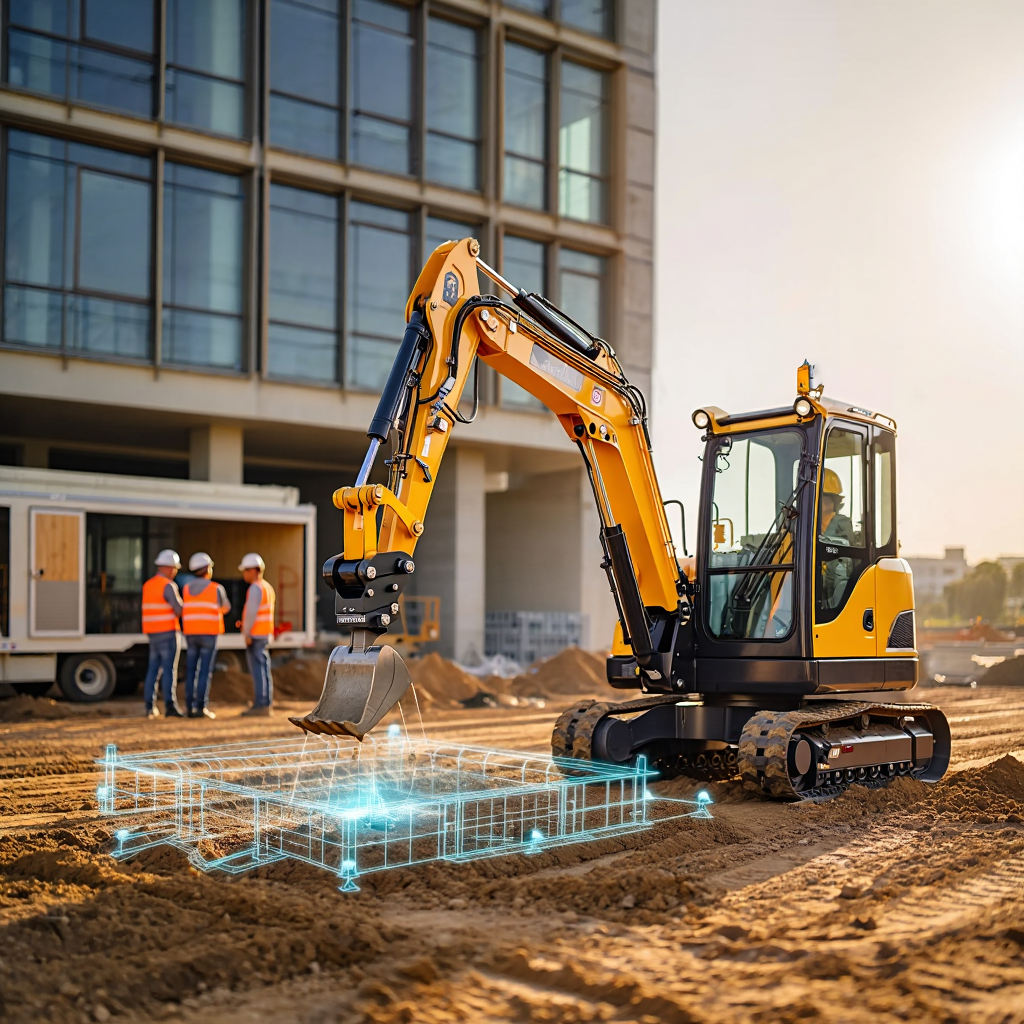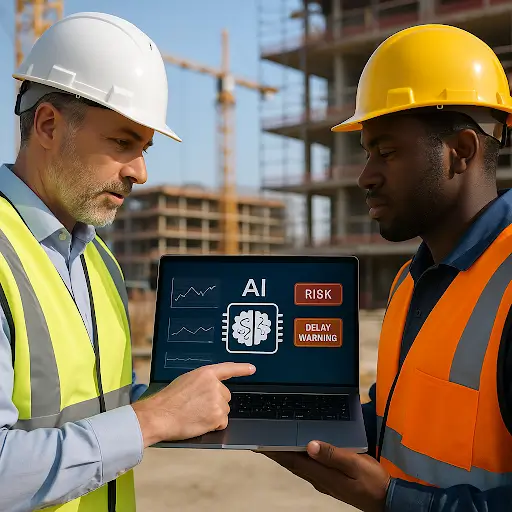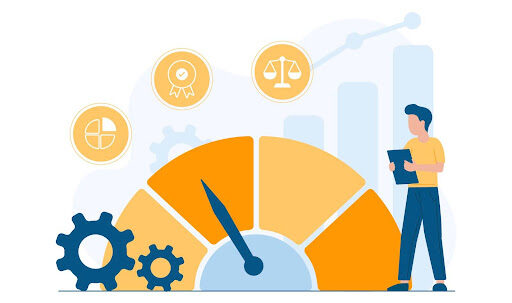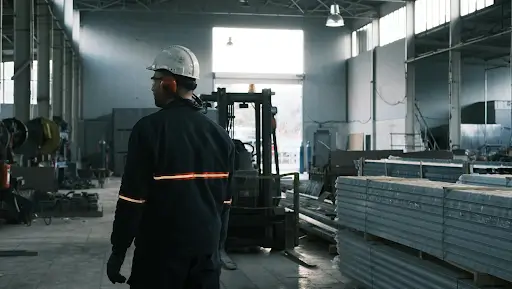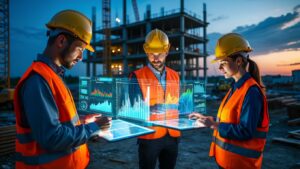Construction leaders often face delays, budget overruns, and safety incidents, especially when trying to modernize fragmented systems. Legacy tools typically lack the ability to process live data or anticipate issues, leaving critical inputs like weather updates, equipment logs, and sensor alerts scattered across platforms.
AI helps organize and apply this data more effectively. Models trained on project-specific inputs can flag scheduling risks, predict equipment failures, and identify safety concerns from video or sensor feeds. RTS Labs works with construction teams to build and embed these models into their existing systems, so insights are delivered where they’re needed, without disrupting established workflows.
This guide details how AI can resolve persistent inefficiencies in construction, and how RTS Labs equips enterprise teams to deploy these solutions at scale with measurable results.
What Is AI in Construction?
AI in construction applies machine learning algorithms, computer vision, and predictive analytics to enhance planning accuracy, automate repetitive tasks, and reduce safety incidents. It leverages data from project schedules, sensor networks, equipment telemetry, and site footage to improve operational control and decision-making.
While adoption has lagged behind sectors like finance and logistics, construction firms, particularly those managing large-scale infrastructure and commercial developments, are beginning to see tangible benefits. AI is being used to forecast project delays based on historical patterns, identify safety hazards through real-time video analysis, and automate routine inspections or maintenance triggers.
Fragmented systems and inconsistent data quality remain key challenges, but forward-looking teams are building AI-driven workflows that integrate seamlessly with BIM, ERP, and site management platforms. These implementations are already showing measurable improvements in cost predictability, worker safety, and execution speed.
Key technologies that power AI in construction
AI in construction is driven by a combination of advanced technologies that turn raw data into actionable insights across the project lifecycle:
- Machine Learning (ML): Analyzes historical project data, such as schedule delays, resource usage, and inspection records, to predict timelines, flag emerging risks, and suggest resource adjustments in real time.
- Computer Vision: Processes live video streams and sensor inputs to detect safety violations, track progress against 3D models or digital blueprints, and identify material or structural deviations without manual checks.
- Natural Language Processing (NLP): Converts unstructured site data, including RFIs, daily logs, safety reports, and contracts, into structured formats that can be analyzed for compliance, trends, and bottlenecks.
- Predictive Analytics: Synthesizes data from past projects, live job site feeds, and planning systems to anticipate cost overruns, forecast equipment maintenance needs, and identify likely schedule disruptions.
These technologies deliver the greatest value when embedded within systems construction teams already rely on, such as Building Information Modeling (BIM) platforms, Enterprise Resource Planning (ERP) tools, and cloud-based project management suites. When integrated at the platform level, AI enables real-time decision support from design through execution, improving visibility, control, and coordination across every project phase.
Suggested Read: 5 Ways AI Demand Forecasting Can Enhance Your Business Success
Common Misconceptions About AI in Construction
AI Does Not Eliminate the Need for Human Oversight:
One common misconception is that AI automates every aspect of construction management or replaces human decision-making entirely. In reality, AI identifies risks, flags potential delays, and recommends resource reallocations, but it cannot independently execute project changes. Construction environments are dynamic, and AI systems rely on experienced professionals to interpret outputs, validate suggestions, and apply them within project and safety constraints.
AI Enhances, Not Replaces, Skilled Roles on Site:
Roles such as project managers, site engineers, and safety officers remain critical. AI tools streamline repetitive tasks like schedule monitoring, compliance checks, or incident logging, allowing teams to focus on complex decision-making and stakeholder coordination. For example, a site supervisor can use AI-generated alerts from sensor data to prioritize inspections or adjust workflows without spending hours analyzing raw logs. Rather than displacing workers, AI expands their capacity to manage more variables with greater speed and precision.
How RTS Labs Addresses AI Misconceptions in Construction
RTS Labs equips construction teams with AI tools that augment daily decisions, like flagging unsafe conditions or forecasting labor needs, without replacing core roles. Models are embedded into existing systems such as BIM and ERP, so crews interact with insights in the tools they already use. Governance features ensure every output is traceable, compliant, and aligned with jobsite realities.
Learn more about RTS Labs’ AI Consulting Services
Strategic Benefits of Artificial Intelligence in Construction
When applied effectively, AI enhances how construction firms plan, allocate resources, and manage risks, without disrupting existing workflows or roles. It adds precision to forecasting, enables faster interventions on-site, and strengthens compliance where manual methods fall short.
Proactive Risk Identification and Control
Project delays often stem from variables that compound, weather shifts, vendor unreliability, labor shortages. AI systems can analyze these inputs together, exposing risk patterns early in the planning cycle:
- Models forecast disruptions by drawing on supplier histories, local labor trends, and environmental data.
- Algorithms trained on past projects highlight risk clusters based on location, contractor type, or timeline complexity.
- Dynamic risk scoring tools help managers prioritize response based on impact potential, not guesswork.
Example: A contractor was alerted to a probable materials delay 14 days in advance. By adjusting the procurement source, the team avoided rework and schedule slippage. Forecasting becomes forward-looking and data-grounded, allowing for informed decisions before costs escalate.
Related Read: Predictive Analytics in Real Estate
Continuous, Data-Driven Safety Oversight
On high-risk job sites, even small oversights can lead to major incidents. AI introduces a layer of monitoring that works in real time:
- Vision systems spot safety violations, like missing harnesses or zone breaches, and trigger immediate escalation.
- Wearables detect irregular motion, fatigue, or prolonged inactivity, helping supervisors intervene before incidents occur.
- Algorithms assess environmental and behavioral inputs to predict when and where safety risks are most likely to emerge.
Example: After detecting a worker in a restricted zone, the system sent a real-time alert that prompted a site lead to intervene, preventing what could have been a serious incident.
The outcome: improved response time, fewer near-misses, and stronger adherence to regulatory protocols.
Smarter Resource Management
AI improves how labor and equipment are allocated by aligning field conditions with real-time project demands:
- Labor planning tools assign crews based on certifications, past performance, and availability, ensuring the right mix of skills on site.
- Dynamic scheduling engines adjust timelines automatically when delays occur due to weather, delivery lags, or access issues, reducing idle time and minimizing rework.
- Equipment analytics track usage patterns, downtime, and maintenance cycles to inform decisions on fleet sizing, rentals, and preventive servicing.
Example: Midweek schedule adjustments guided by AI forecasts allowed a superintendent to reassign crews, cutting idle hours and reducing overtime costs.
Targeted deployment of labor and assets leads to higher productivity and tighter budget control.
Accelerated Decision-Making with Unified Project Data
Construction sites generate vast streams of data, from BIM files and drone imagery to inspection logs and IoT telemetry. AI consolidates this information to speed up field and executive-level decisions:
- Unified dashboards display real-time progress, cost tracking, and compliance status in one interface, eliminating the need to toggle between multiple systems.
- Anomaly detection algorithms flag cost spikes, quality deviations, or scheduling gaps early, giving teams a head start on corrective actions.
- Scenario modeling tools allow planners to evaluate multiple paths, such as shifting subcontractor timelines or resequencing tasks, along with projected trade-offs in cost and duration.
Example: A project lead identified a cost variance three weeks before it would have surfaced in manual reports. Early scope adjustment kept the project on budget.
With centralized insights, decision-makers act faster and with greater precision, without relying on fragmented reporting or delayed escalations.
Improved Compliance and Documentation Accuracy
Construction teams spend significant time managing permits, inspection records, and regulatory documents. AI reduces manual workload by automating these tasks and improving traceability:
- Robotic Process Automation (RPA) populates compliance forms, tracks submissions, and maintains version control, ensuring documents stay current across changing requirements.
- Natural Language Processing (NLP) scans contracts, permits, and inspection reports to extract clauses, expiration dates, and regulatory conditions for easier tracking.
- AI-tagged document repositories create searchable audit trails, reducing the risk of missing or outdated files during compliance reviews.
Example: During a safety audit, a compliance officer retrieved a required inspection log in seconds using AI-based metadata tagging, eliminating what would have been hours of manual searching.
By streamlining documentation workflows, teams reduce audit risk, maintain regulatory accuracy, and recover valuable staff time.
How AI Is Used in Construction Today?
No longer limited to R&D, AI is now integrated into day-to-day construction workflows, enhancing forecasting, compliance, and resource utilization.
1. Predictive Maintenance for Equipment
AI analyzes sensor data from machinery, like vibration, temperature, and cycles, to predict failures before they occur.
Example: Komatsu uses predictive maintenance for its hydraulic excavators by analyzing sensor data such as pressure, temperature, and vibration. This AI-powered system identifies early signs of component wear or malfunction. As a result, Komatsu can schedule maintenance proactively, prevent equipment failure, and reduce downtime leading to lower repair costs and improved equipment reliability in the field.
2. AI-Based Project Scheduling
By integrating historical project data, weather forecasts, and supply chain info, AI tools optimize schedules dynamically.
Example: Mid-project rain events triggered schedule shifts, with AI recommending task reorderings that minimized resource downtime.
According to a study by IOSR Journal of Mechanical and Civil Engineering, ML models have demonstrated up to 88% accuracy in forecasting project duration and cost overruns when trained on historical project data.
3. Drone and Camera-Based Safety Monitoring
Computer vision systems analyze site footage to flag safety hazards, unhelmeted workers, unsafe distances, tripping risks, instantly.
Example: A worker entering a no-go zone triggered an alert via site cameras, prompting an immediate safety check and avoiding potential injury.
Pillar Technologiesmonitors site conditions with sensors that generate over 1.2 million data points daily. The system flags risks like temperature, humidity, air quality (including VOCs and carbon monoxide), noise levels, and ambient light, in real time and powers predictive analytics to prevent incidents. This system led to cut air quality violations by 75% and boosted safety compliance.
4. Automated Design and BIM Enhancement
Generative AI tools enhance BIM models through clash detection, routing optimization, and design iteration.
Example: An AI tool reviewed a BIM model and suggested optimizing MEP routing, saving hours of manual rework and improving buildability.
A study published in Results in Engineering in November 2024, applied a Modified XGBoost (MXGBoost) model to automate clash detection in BIM workflows, achieving 94.1% precision and an R² score of 0.928. The AI analyzed architectural, structural, and MEP data to accurately predict spatial conflicts before construction began. These results show how AI can significantly enhance BIM coordination by identifying clashes early and improving project outcomes.
5. Labor Forecasting and Productivity Tracking
AI combines crew skill data, productivity history, and project scope to forecast labor needs and monitor performance.
Example: Crew output dropped 15%, and AI flagged the trend, supervisors rebalanced tasks, reducing projected overtime by 20%.
Corscale, a U.S. data center developer, used AI-driven site analytics on major projects inVirginia to accelerate delivery and reduce waste. The system analyzed 3D scans against BIM models and schedules, enabling the team to reassign crews based on real-time productivity data and flag schedule slips early.
6. Document Processing and Compliance Automation
NLP and robotic process automation extract and organize permit deadlines, contract clauses, and inspection logs.
Example: At closeout, a site manager located all inspection approvals in minutes using AI-tagged compliance documents.
7. Site Inspection and Progress Tracking (via Computer Vision)
AI-powered cameras compare real-time site images with BIM plans, tracking completion rates and detecting defects.
Example: Daily drone images revealed inconsistencies in the concrete pour; AI analysis enabled quality corrections before flooring installation.
InDubai’s Burj Jumeirah project, drones equipped with LiDAR and high-res cameras captured real-time 3D models of the construction site. AI systems analyzed this data to detect anomalies, trigger alerts for delays or safety concerns, and compare actual progress against the BIM model. This integration reduced inspection time by 30% and helped identify over 50 potential hazards before incidents occurred. The case demonstrates how drones and AI can scale effectively to manage complex, high-stakes construction environments.
Preparing Construction Teams for AI-Enabled Execution in 2025
In 2025, AI will guide how construction teams plan sequences, allocate crews, and respond to on-site changes. RTS Labs enables this shift by identifying specific opportunities, such as labor planning or dynamic scheduling, and engineering targeted integrations that connect project data with decision models.
Rather than replatforming, RTS builds on existing tools like BIM and ERP, ensuring models work within current workflows. Each deployment includes structured governance for data integrity, compliance alignment, and sustainable model performance, ensuring AI continues to deliver value throughout execution.
Learn how to use AI for business growth, from planning to execution and strategy.
How to Use AI in Construction Successfully: A Practical 5-Step Plan
Successfully using AI in construction requires a focused strategy, the right technical foundation, and ongoing iteration based on project feedback. Here’s a five-step process construction leaders can follow to turn AI initiatives into measurable business outcomes:
Step 1 – Evaluate Readiness Across Data, Systems, and Stakeholders
Start by assessing whether your environment can support AI in both technical and operational terms.
- Data Access: Confirm whether you have usable datasets, such as safety records, equipment telemetry, BIM models, and project schedules, that AI models can train on and analyze.
- System Architecture: Review your tech stack for cloud compatibility, data integration, and system interoperability. Rigid legacy systems often create friction points.
- Executive Alignment: Ensure leadership teams and field managers understand how AI supports project outcomes. Without buy-in, initiatives stall before reaching implementation.
Action: Conduct a formal readiness audit across architecture, data maturity, compliance frameworks, and team capabilities.
Step 2 – Prioritize Use Cases With High ROI and Fast Validation
Anchor your AI strategy in business challenges, not technology exploration.
- Problem-Driven Approach: Focus on repeat pain points, e.g., chronic schedule slippage, overuse of labor, or audit delays.
- Evaluation Criteria: Rank use cases based on expected value, implementation effort, and availability of relevant data.
- Early Wins: Select 1–2 use cases that offer tangible returns and low deployment friction, such as automating permit tagging or improving labor forecasts.
Example: Deploying NLP to automate document reviews often yields faster gains than investing early in generative design tools.
Step 3 – Define a Phased Rollout Strategy With Clear KPIs
Set scope and expectations with a roadmap that includes pilot phases, evaluation checkpoints, and governance plans.
- Pilot First: Begin with a single system or workflow (e.g., inspection log classification) to manage risk and simplify feedback loops.
- Quantify Benefits: Estimate savings in labor hours, reduction in rework, or improvements in risk detection, then establish performance metrics.
- Governance Plan: Define roles for oversight, auditability, access permissions, and bias mitigation upfront.
This phased approach gives space to iterate without compromising operational stability or budget constraints.
Step 4 – Select and Integrate the Right Technical Stack
Choose development and deployment methods based on integration needs and internal capabilities.
- Custom AI Builds: Recommended for firms managing complex operations or proprietary data workflows.
- Prebuilt Tools: Suitable for narrow tasks like video-based PPE detection or optical character recognition in compliance documents, though often limited in flexibility.
- Integration Considerations: Evaluate how easily tools connect with platforms such as BIM, ERP, and scheduling systems via APIs.
- Deployment Architecture: Decide between cloud, on-premises, or hybrid setups based on latency tolerance, data security, and scalability requirements.
Most mid- to large-sized firms benefit from hybrid strategies: secure cloud-based models integrated through APIs into core platforms.
Step 5 – Monitor Continuously, Refine Models, and Train End Users
AI is not a “set and forget” system, it must evolve alongside projects and users.
- Model Updates: Retrain AI models periodically using new data to maintain prediction accuracy and site relevance.
- Operational Feedback Loops: Use real-time dashboards to compare AI recommendations against outcomes, then fine-tune model behavior.
- Team Enablement: Equip project managers, site leads, and compliance officers with guidance on interpreting outputs and embedding insights into daily workflows.
Governance protocols should include role-based access, audit trails, and transparent documentation of model behavior. Tracking performance through defined metrics, such as reduced incidents, hours saved, or rework avoided, helps justify further expansion across the organization.
Why RTS Labs Is the Right AI Partner for Construction?
AI in construction must do more than deploy models. It must address real-world challenges like scheduling delays, safety risks, and resource constraints in high-pressure environments.
RTS Labs combines strategy, hands-on execution, and fast delivery to ensure AI drives results where it counts, on-site, within budget, and on schedule.
Custom-Built AI for Real-World Problems
RTS Labs focuses on practical impact, not AI hype, using an approach built around your actual project needs:
- Targets operational bottlenecks, not hypothetical AI use cases.
- Delivers custom solutions, not platform-bound tools.
- Pair senior AI consultants with project leads to embed AI directly into daily workflows.
From predictive scheduling to automated documentation, each solution is designed for implementation on active sites, not just for concept decks.
90-Day Path to ROI
RTS Labs accelerates AI implementation with a focused, milestone-driven process that avoids long timelines and unnecessary complexity. Our structured engagement model includes:
- Use case discovery workshops
- Rapid prototyping with real data
- Seamless integration into BIM, ERP, or field tools
- Performance tracking with clear KPIs
Most clients see measurable ROI within 90 days, whether in time saved, risks avoided, or costs reduced.
Trusted by Construction Teams
RTS Labs recently partnered with a general contractor managing high-volume commercial builds. Key results:
- 30% faster risk identification using AI dashboards fed by project and sensor data
- 20% improvement in labor efficiency through adaptive scheduling
- Document handling time cut in half, with NLP automating compliance workflows
RTS Labs builds what construction leaders need: AI that fits, scales, and performs under pressure.
Book a consultation with RTS Labs to discuss your AI goals
From Concept to Construction ROI: Your AI Strategy Starts Here
AI in construction drives real results, from reducing delays and forecasting equipment needs to improve safety and compliance. Success starts with clear use cases, reliable data, and a partner who understands how to embed AI into active projects without disrupting operations.
RTS Labs helps construction teams move fast, helping you end-to-end, from strategy to deployment, delivering AI solutions that integrate with your systems and improve outcomes in weeks, not years.
Let’s turn your AI goals into measurable impact.
Book a strategy session with RTS Labs.
FAQs
How is AI different from automation in construction?
Automation handles repetitive tasks using pre-set rules. AI, on the other hand, analyzes data, learns patterns, and makes decisions, enabling predictive scheduling, safety monitoring, and intelligent risk assessment.
What’s the ROI timeline for AI in construction projects?
ROI typically begins within three to six months of deployment, depending on the use case. High-impact areas like predictive maintenance and project scheduling optimization show fast value.
Can AI work with existing legacy systems?
Yes. RTS Labs designs AI solutions to integrate with ERPs, CRMs, BIM platforms, and sensor networks. Our phased approach minimizes disruption and maximizes compatibility.
What kind of data do we need to get started with AI?
Structured data (e.g., schedules, budgets, asset logs) and sensor inputs (e.g., cameras, IoT) are a strong start. We help assess your data readiness and build clean, usable pipelines.
How do we know if AI is worth the investment?
We start with feasibility assessments and ROI modeling. If your project has measurable inefficiencies or repeatable decisions, AI can likely deliver value. The key is defining the right use case.
